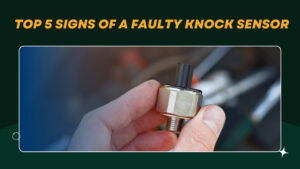
Top 5 Signs of a Faulty Knock Sensor
If you suspect an issue with your knock sensor, here are the top 5 common symptoms to watch out for:
1) Check Engine Light
The first and most noticeable symptom of a faulty knock sensor is the illumination of the Check Engine warning light on your dashboard.
It’s important to note that while a bad knock sensor is one potential cause for the Check Engine light to come on, there could be other reasons as well. Therefore, it is essential not to ignore this warning as it could lead to serious consequences for your engine.
Some possible trouble codes related to a faulty knock sensor include: P0325, P0326, P0327, P0328, P0329, P0330, P0331, P0332, P0333, and P0334.
2) Loud Noises (Noise while driving)
When the knock sensor malfunctions, you may hear loud noises emanating from the engine, resembling thumping sounds. If left unfixed, these sounds will only grow louder over time.
These noises occur due to the improper ignition of the air and fuel mixture within the cylinder, instead of reaching the combustion point. Hearing such noises should prompt you to promptly take your vehicle to a mechanic.
3) Poor Fuel Efficiency (High fuel consumption)
If you observe a decrease in the number of miles per gallon you are achieving, a faulty knock sensor could be a contributing factor. While there are various reasons for poor fuel efficiency, noticing other symptoms in conjunction with this issue could indicate a bad knock sensor as the root cause.
4) Poor Acceleration (car won’t accelerate)
If your car is not accelerating when you press the gas pedal, it could be due to a faulty knock sensor. This issue may be confirmed if you are also experiencing other symptoms mentioned earlier.
5) Poor Engine Performance (car won’t accelerate)
When a knock sensor is faulty and not replaced promptly, it can lead to severe damage to internal engine components. As a result, your vehicle may start to lag and jerk while driving. Additionally, you may notice a burning smell from the engine that could permeate the cabin. Continuing to drive in this condition could ultimately lead to complete engine failure, requiring expensive repairs.

